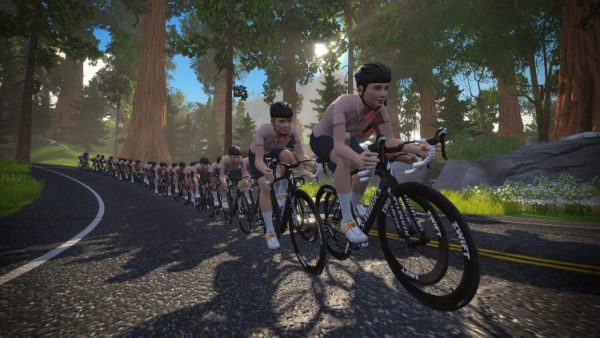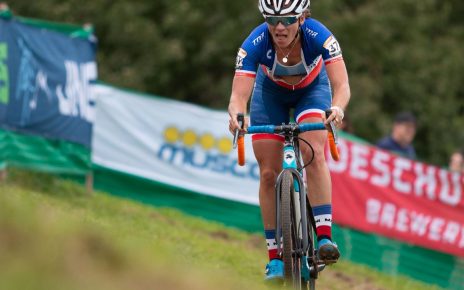By Chris Carmichael, Founder and Head Coach of CTS
Cyclists looking for fun, camaraderie, and competition are flocking to virtual racing and discovering… it’s really hard! For cyclists who have been riding and racing outdoors for years or decades, it’s important to recognize that virtual racing is not going to be – nor does it intend to be – a perfect replication of outdoor racing. Some parts are very similar, but to be successful you have to adjust your habits and strategies for a new discipline. And one of the biggest adjustments you have to make relates to the start.
Get to the start early
Starting position matters in virtual racing, particularly in larger events with hundreds of riders. You can click “Join the event” up to 30 minutes before the actual start time, and your avatar will be placed in the starting pen. If you register for the event and choose to ride a Zwift route while waiting for the event to start, you can “join the event” at the last minute but you’ll be at the back and out of luck.
Start hard or lose position instantly
Think of the beginning of a Zwift race as a flying start. When the clock counts down to zero you need to be at full power in order to stay near the front of the race. The pace is ballistic for the first few minutes – in any category – as riders try to break the peloton into groups. Keep an eye on your position in the pack and experiment with the “camera angles” to find a view that lets you see if gaps are opening up. The power demand to stay with the lead group may be as high as 150% of threshold for 1-3 minutes, but if you can hang on, the pace will let up (a bit).

Warm up really well
Getting dropped at the start of a race sucks in the real world and on a virtual course. When you know the start is going to be a huge effort, a great warmup is going to be a key component for success. There are two ways to go about it: the long and moderate way or the short and hard way. From an informal and anecdotal survey of CTS Coaches and Athletes, it seems more athletes prefer the short and hard version. Older athletes may find they need more time to get the aging engine and muscles up to speed, and may perform better after the longer warmup.
What happens during a warmup
In an emergency you can go from rest to a full sprint instantaneously, but when you are not relying on your fight or flight mechanism it takes more time to transition the body from rest to high performance.
During your warmup, you’re increasing your body’s demand for oxygen, so your blood vessels dilate to deliver blood to working tissues more quickly. All that work increases core temperature, and your body responds by increasing sweat production. There’s a lag time in there, too, when you’re producing a lot of heat before you’re producing a lot of sweat. Getting through that lag time is important because you want your body’s cooling system working at full capacity before the starting gun goes off. Interestingly, one of the long-term adaptations to endurance training is a quicker sweat response. As an athlete your body knows what’s coming and opens the floodgates to keep core temperature from skyrocketing.
Your energy systems also need some time to transition from their at-rest status to their competition status. The mechanisms for producing and processing lactate are particularly important to activate. You’re always producing and processing a small amount of lactate, but to be ready for competition, you need to kick lactate production into high gear so the speed at which you can process lactate also increases.
The two warmup routines below are examples of tailored for the hard start demands of virtual racing, and will work for criteriums, cyclocross, and short track mountain bike racing (when we can all do those things again).
Short and Hard Race Warm-up (20 Minutes)

- 5 minutes easy pedaling
- 1:30 at 65% of Threshold
- 1:00 at 75% of Threshold
- 0:30 at 85% of Threshold
- 3 minutes easy pedaling
- 1:30 at 75% of Threshold
- 1:00 at 90% of Threshold
- 0:30 at 100% of Threshold
- 3 minutes easy pedaling
- 1:00 at 75% of Threshold
- 0:30 at 120-140% of Threshold
- 1:00 easy spinning recovery
- 0:30 at 120-140% of Threshold
- 1:00-plus of easy spinning until the actual start. Crank up to full power in the 30 seconds prior to the start.
Long and Moderate Warm-up (40 Minutes)

- 5 minutes easy pedaling
- 5 minutes at 75% of Threshold
- 1 minute FastPedal Interval, 100+rpm and light resistance
- 1 minute easy pedaling
- 1 minute FastPedal Interval, 100+rpm and light resistance
- 4 minutes at 100% of threshold and 90-95rpm
- 2 minutes easy pedaling
- 4 minutes at 100% of threshold and 90-95rpm
- 2 minutes easy pedaling
- 5 minutes at 75% of Threshold
- :15 seconds sprint
- 2 minutes easy pedaling
- :15 seconds sprint
- 2 minutes easy pedaling
- :15 seconds sprint
- 4:15 minutes easy pedaling until the actual start. Crank up to full power in the 30 seconds prior to the start.
Assets provided by trainright.com



